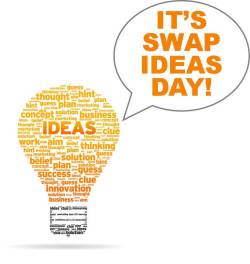brand ambassadors
It’s Swap Ideas Day So Get Creative!
 Today, September 10, 2014 is Swap Ideas Day! According to the Days of the Year website, the idea behind Swap Ideas Day is that everybody gets together to exchange ideas.
Today, September 10, 2014 is Swap Ideas Day! According to the Days of the Year website, the idea behind Swap Ideas Day is that everybody gets together to exchange ideas.
“People celebrate this occasion by connecting with other people to share thoughts and concepts. There are no rules outlining the nature of the ideas to be shared, thus making Swap Ideas Day an ideal opportunity for people to be as creative and wacky as they like with their ideas as well as learning from the ideas of others.”
Time for all you marketing-minded people to get creative! Here are 5 suggestions: Continue reading
The Smart Way to Use Donor Gifts
Do thank-you gifts actually increase contributions? According to a recent article in The Wall Street Journal, two Yale University researchers tried to answer this question in a 2012 study of charitable behavior.
Once again, research shows that using fundraising incentive gifts don’t work. In fact, “We found when you offer a thank-you gift as part of an initial donation request—such as a pen, tote bag, or mug—people end up donating less than if you just asked them how much they’d be willing to donate,” says George E. Newman, an assistant professor of organizational behavior at Yale’s School of Management.
“People seem to be concerned that if they were to accept the thank-you gift, it would create ambiguity about their reasons for giving,” adds Newman. “There’s actually a very long literature in psychology on this idea, known as the ‘crowding-out’ effect, where a person’s intrinsic motivation ends up decreasing once an external incentive is added.”
On the other hand, Roger Dooley, neuromarketing expert and author, says that using free address labels, greeting cards, and other items that show up in your mailbox, accompanied by a request for a donation, actually do work.
“The psychological principle involved is ‘reciprocity’ – when you get those mailing labels, you feel a subtle urge to reciprocate by making a donation. There is even data that shows the size of the gift accompanying the request can have a big influence on donations.” Continue reading
Happy “Interdependence” Day!
 On July 1st, Canada turns 146, and on July 4th, America marks its 237th year of independence. As we celebrate the independence of these two great nations, it made me think of the ways in which we work today.
On July 1st, Canada turns 146, and on July 4th, America marks its 237th year of independence. As we celebrate the independence of these two great nations, it made me think of the ways in which we work today.
Whether you work for a small business or a nonprofit organization, what does independence look like in your workplace? Does your organization work independently from others? What about its departments or areas of responsibility? Do people collaborate and share information?
The Collins English dictionary defines interdependence as “dependence between two or more people, groups, or things.” Now, that’s more realistic, isn’t it? When we collaborate and work for a common objective, we can accomplish so much more.
Earlier this year, Cisco conducted an internal study called the Cisco Collaboration Work Practice Study, in which it uncovered that “employees value collaboration. Working together and having multifaceted perspectives trumps working alone and often leads to idea propagation.” The company said its recommendations will work for any organization that wants to derive greater business value by improving collaboration.
In a post-PC world, collaboration is more critical than ever. It means getting the right information to the right people at the right time to make the right decision. In turn, these well-informed and quicker decisions help organizations get work done, fostering productivity, innovation, and growth.”
The nonprofit sector has embraced interdependence in the past few years, partly out of necessity during the Great Recession, and partly because they’ve seen how successful it can be. When organizations collaborate, they can surely make more of a difference to their mutual causes.
I’ve also seen an increase in smaller businesses working interdependently, even with competitors. If Company A provides a service that Company B does not, and vice versa, it can be of mutual benefit when they collaborate, rounding out their business offerings so they don’t have to turn their own customers away. It’s a win-win for both sides.
Now, you may be wondering what this has to do with marketing. It’s quite simple. When employees collaborate and work interdependently, they are more satisfied and engaged.
And, when they are more engaged internally, they will be better brand ambassadors externally. Providing exceptional customer service to your customers, clients, donors, volunteers, members, etc., is what helps your brand stand out and bring people back.
So, Happy Interdependence Day! And, to my Canadian readers, Happy Canada Day! To my American readers and friends, Happy 4th of July!
Want Your Organization to Perform Better? Engage Your Employees!
There are increasing statistics that show your employees can make or break your small business or nonprofit organization. The latest study from Dale Carnegie and MSW digs further into what creates engaged employees, and what key attributes are present within these engaged employees.
To me, the most important take-away is this one fact:
Companies with engaged employees outperform those that don’t by up to 202%!!!
You’d think that most organizations would focus on their employees in order to do better, right? Then, how come 71% of employees are NOT fully engaged at work and $11 billion is lost annually due to employee turnover???
So, what are the characteristics of an engaged employee?
- Enthusiasm
- Inspired
- Empowered
- Confident
And, how can your small business or nonprofit accomplish this? Well, internal marketing can play a large role. Your employees are your first market and can be your org’s best brand ambassadors.
The study’s authors provide five tips you can see below in this excellent infographic.
Take a look and then share some best practices that demonstrate how your organization engages its employees.







